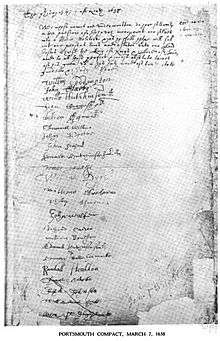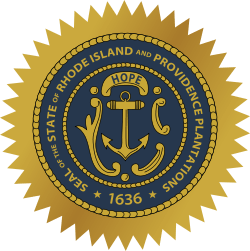John Coggeshall
| John Coggeshall | |
|---|---|
 John Coggeshall grave medallion | |
| 1st President of the Colony of Rhode Island and Providence Plantations | |
|
In office 1647–1647 | |
| Preceded by | position created |
| Succeeded by | Jeremy Clarke |
| Personal details | |
| Born |
baptized 9 December 1601 Halstead, Essex, England |
| Died |
27 November 1647 Newport, Rhode Island |
| Resting place | Coggeshall Cemetery, Newport, Rhode Island |
| Children | John, Anne, Mary, James, Joshua, Hananiel, Wait, Bedaiah |
| Occupation | Merchant, selectman, deputy, corporal, moderator, president |
John Coggeshall (1601 – 27 November 1647) was one of the founders of Rhode Island and the first President of all four towns in the Colony of Rhode Island and Providence Plantations. Coming from Essex, England as a successful merchant in the silk trade, Coggeshall arrived in the Massachusetts Bay Colony in 1632 and quickly assumed a number of roles in the colonial government. In the mid-1630s he became a supporter of the dissident ministers John Wheelwright and Anne Hutchinson. When Hutchinson was tried as a heretic in 1637, Coggeshall was one of three deputies who voted for her acquittal. Hutchinson was banished from the colony in 1638, and the three deputies who voted for her acquittal were also compelled to depart.
Before leaving Boston, Coggeshall and many other Hutchinson supporters signed a compact in March 1638 agreeing to form a government based on the individual consent of the inhabitants. They then established the new colony of Portsmouth on Aquidneck Island, also called Rhode Island, in the Narragansett Bay, later one of four towns comprising the Colony of Rhode Island and Providence Plantations.
Coggeshall was once again very active in civil affairs, but a rift in the leadership of the colony caused him and several other leaders to leave in 1639, and move to the south end of the island, establishing the town of Newport. The two towns of Portsmouth and Newport reunited in 1640 under the leadership of William Coddington, and Coggeshall was his assistant until 1647 when the two towns of Rhode Island united to form a common government with the towns of Providence and Warwick, and Coggeshall was elected President of the entire colony of four towns. His tenure was very short due to his death later the same year, but during his administration many excellent laws were established, becoming the legal basis for both the colony and state of Rhode Island.
England and Massachusetts
John Coggeshall, the son of John and Ann (Butter) Coggeshall, was born and raised in northeastern Essex, England, being baptized at Halstead.[1] After his marriage he lived four miles (six km) away in Castle Hedingham where several of his children were baptized, and where he was a merchant prior to his emigration.[2][3] In 1632, Coggeshall and his family joined the mass immigration of English Puritans to New England, sailing on the Lyon, the same ship that brought Roger Williams the year before.[4][5] The Coggeshalls first settled at Roxbury where they were admitted to the Roxbury Church the year of their arrival, and where John Eliot would soon be the pastor.[6] In 1634 Coggeshall moved with his family to Boston where he and his wife were admitted to the church on 20 August,[4] and where they became the next door neighbors of William and Anne Hutchinson.[7]

Coggeshall was a mercer, specifically involved in the silk trade, and held many offices in the Massachusetts Bay Colony.[8] He was a deputy to the General Court for Boston from 1634 to 1637 and a Boston selectman during the same period. In 1634 he was also on a committee to survey Mount Wollaston, and on a committee to oversee ammunition.[8]
Some time after moving to Boston, Coggeshall became an enthusiastic supporter of Anne Hutchinson, the controversial dissident minister and preacher. Also supporting her initially was the Reverend John Cotton, and a majority of the Boston church members.[9] Even the governor of the colony, Henry Vane was a strong admirer of Mrs. Hutchinson, but he was voted out of office, and when John Winthrop became the governor strong measures were taken to "stamp out heresy and drive out the heretics."[9] Because of her religious opinions, and her influence in conveying her ideas within the community, Mrs. Hutchinson was tried, convicted, and banished from the colony during the Antinomian Controversy.[9] At her civil trial, Coggeshall spoke out in her defense and was one of only three deputies to vote for her acquittal, the other two being William Aspinwall and William Coddington.[9] [Actually, "Coddington and Colburn alone dissented," according to [10]] Coggeshall also supported another dissident minister, the Reverend John Wheelwright, whose wife was the sister of Anne Hutchinson's husband. Shortly after Hutchinson's banishment, Coggeshall was expelled from the General Court and in March 1638, was also directed to leave Massachusetts.[9]
Scores of Mrs. Hutchinson's followers were ordered out of the Massachusetts colony, but before leaving Boston a group of them, including Coggeshall, signed what was later called the Portsmouth Compact, establishing a non-sectarian civil government upon the universal consent of the inhabitants, with a Christian focus.[9] Planning initially to settle in New Netherland, the group was persuaded by Roger Williams to purchase some land of the Indians on the Narragansett Bay. They settled on the north east end of Aquidneck Island, and established a settlement they called Pocasset, but in 1639 changed the name to Portsmouth.[11] William Coddington was elected the first judge (governor) of the settlement.[12] In May 1638 Coggeshall was on a committee to lay out land there, and was granted six acres at the same time.[8] The following year a disagreement prompted Coddington and a few other leaders, including Coggeshall, to leave Portsmouth and begin a new settlement at the south end of the island called Newport.[13] In his journal, Governor Winthrop described the 1639 disagreement in Portsmouth, writing, "the people grew very tumultuous and put out Mr. Coddington and the other three magistrates," Coggeshall being one of the three alluded to by Winthrop.[14]
Rhode Island

Coggeshall was soon a leader in Newport, and was granted 400 acres (1.6 km2) of land on the south side of the town, along present-day Bellevue Avenue. In the first election in 1638, he was elected as treasurer, and in 1640 he became an assistant to the governor, which position he held continuously until 1647.[11] Coggeshall had a good working relationship with Roger Williams, and this relationship helped the four towns of Portsmouth, Newport, Providence and Warwick to unite and form the Colony of Rhode Island and Providence Plantations in the Spring of 1647, under the patent that Williams had obtained from the crown in 1644.[11] In May 1647 Coggeshall was elected the chief magistrate of the four-town colony being given the title of President.[11] He had four assistants, one from each town, a general recorder and a treasurer. Under his administration the courts of justice were established and the first complete code of laws was written.[11] Rhode Island historian and Lieutenant Governor Samuel G. Arnold made this tribute to the digest of statutes enacted under Coggeshall in 1647:
For simplicity of diction, unencumbered as it is by the superfluous verbiage that clothes our modern statutes in learned obscurity; for breadth of comprehension, embracing as it does the foundation of the whole body of law, on every subject, which has since been adopted; and for vigor and originality of thought and boldness of expression, as well as for the vast significance and the brilliant triumph of the principles it embodies, the Digest of 1647 presents a model of legislation which has never been surpassed.[11]— Samuel G. Arnold, writing of the laws established during Coggeshall's administration
Coggeshall was in office only briefly, dying of an illness in Newport on 27 November 1647 and being buried on his own property in Newport. While he is noted for being the first president of the united colony of four towns, he is also noted for helping to establish the three towns of Boston, Portsmouth, and Newport, and the two colonies of Massachusetts Bay and Rhode Island.[11]
Family and legacy
Coggeshall's wife was named Mary, but her maiden name remains uncertain. Some sources claim her maiden name is Gould, another says it is Surgis, but these are undocumented, and having examined the evidence, Charles Anderson and the editors of the Great Migration project conclude her maiden name is not known.[8] Coggeshall and his wife had eight children, five of whom were born in England, and the others born in Boston, but only half of whom are known to have survived to maturity.[8] Their oldest child, John, was very active in colonial affairs over a period of three decades, serving as treasurer, commissioner, assistant and deputy governor.[15] Their second surviving son, Joshua, also served in public office as deputy to the General Court of Rhode Island for all but two years between 1664 and 1672, and as assistant (magistrate) for all but one year from 1669 to 1676. Their oldest daughter, Ann, married Peter Easton, a son of Nicholas Easton who served many terms as either president or governor of the Rhode Island colony.[16] Their other surviving daughter Wayte married Daniel Gould and their descendant Elizabeth Buffum Chace was a known abolitionist with the Underground Railroad.
Places named for President Coggeshall include John Coggeshall Elementary School in Portsmouth, Rhode Island; Coggeshall Way and Coggeshall Circle in rural Middletown; and Coggeshall Avenue in Newport, which goes through the original Coggeshall property. His numerous descendants include painter Sanford Robinson Gifford and composer Jimmy Van Heusen.
See also
- List of colonial governors of Rhode Island
- List of early settlers of Rhode Island
- Colony of Rhode Island and Providence Plantations
- Antinomian Controversy
References
- ↑ Coggeshall 1930, p. 6.
- ↑ Anderson 1995, pp. 406-407.
- ↑ Moriarty 1943, p. 131.
- 1 2 Anderson 1995, p. 405.
- ↑ Austin 1887, p. 430.
- ↑ Anderson 1995, pp. 405, 630-631.
- ↑ Battis 1962, p. 68.
- 1 2 3 4 5 Anderson 1995, p. 406.
- 1 2 3 4 5 6 Bicknell 1920, p. 992.
- ↑ Battis in his book, Saints and Sectaries (1962), on page 208
- 1 2 3 4 5 6 7 Bicknell 1920, p. 993.
- ↑ Bicknell 1920, pp. 992-993.
- ↑ Johnson & Brown 1904.
- ↑ Anderson 1995, p. 482.
- ↑ Austin 1887, p. 49.
- ↑ Austin 1887, pp. 49, 294.
Bibliography
- Anderson, Robert Charles (1995). The Great Migration Begins: Immigrants to New England, 1620–1633. Vol. I. Boston, MA: New England Historic Genealogical Society. pp. 405–9. ISBN 978-0-88082-120-9. OCLC 42469253.
- Austin, John Osborne (1887). Genealogical Dictionary of Rhode Island. Albany, New York: J. Munsell's Sons. ISBN 978-0-8063-0006-1.
- Battis, Emery (1962). Saints and Sectaries: Anne Hutchinson and the Antinomian Controversy in the Massachusetts Bay Colony. Chapel Hill: University of North Carolina Press.
- Bicknell, Thomas Williams (1920). The History of the State of Rhode Island and Providence Plantations. Vol.3. New York: The American Historical Society. pp. 989–994.
- Coggeshall, Charles Pierce (1930). The Coggeshalls in America: Genealogy of the Descendants of John Coggeshall of Newport, with a brief notice of their English antecedents. Boston: C. E. Goodspeed.
- Johnson, Rossiter; Brown, John Howard (1904). The Twentieth Century Biographical Dictionary of Notable Americans II. Boston: The Biographical Society.
- Moriarty, G. Andrews (January 1943). "Additions and Corrections to Austin's Genealogical Dictionary of Rhode Island". The American Genealogist 19: 131–2.
External links
| |||||||||||||||||||||||||||||||||||||||||||||
| |||||||||||||||||||||||||||||||||

